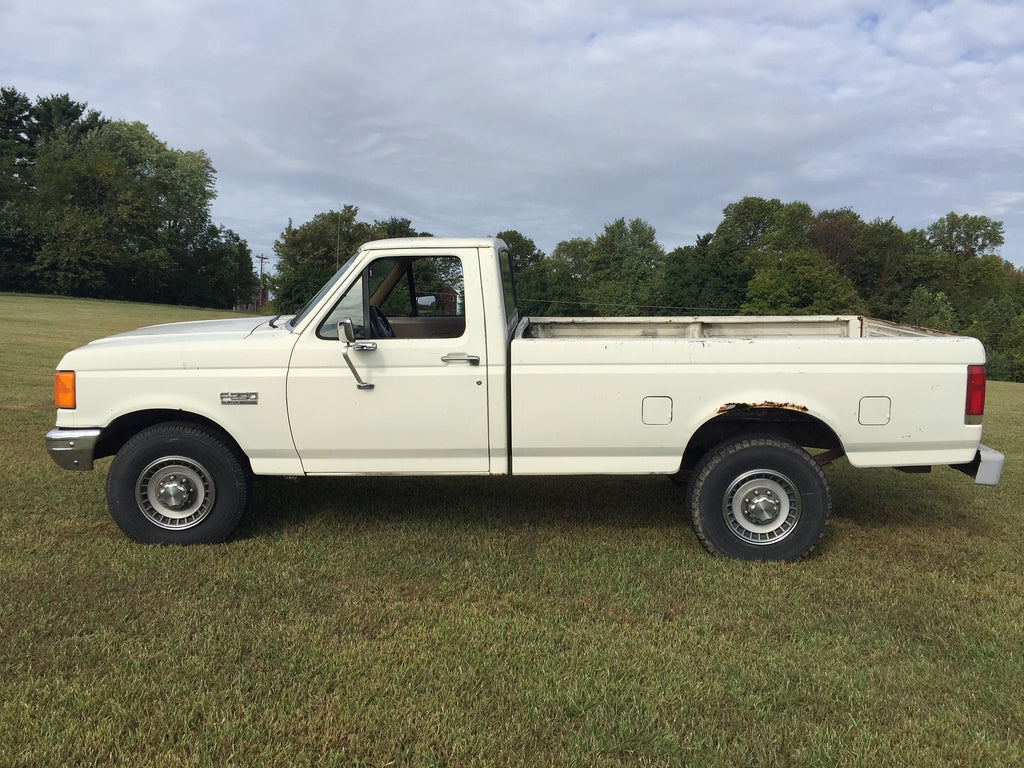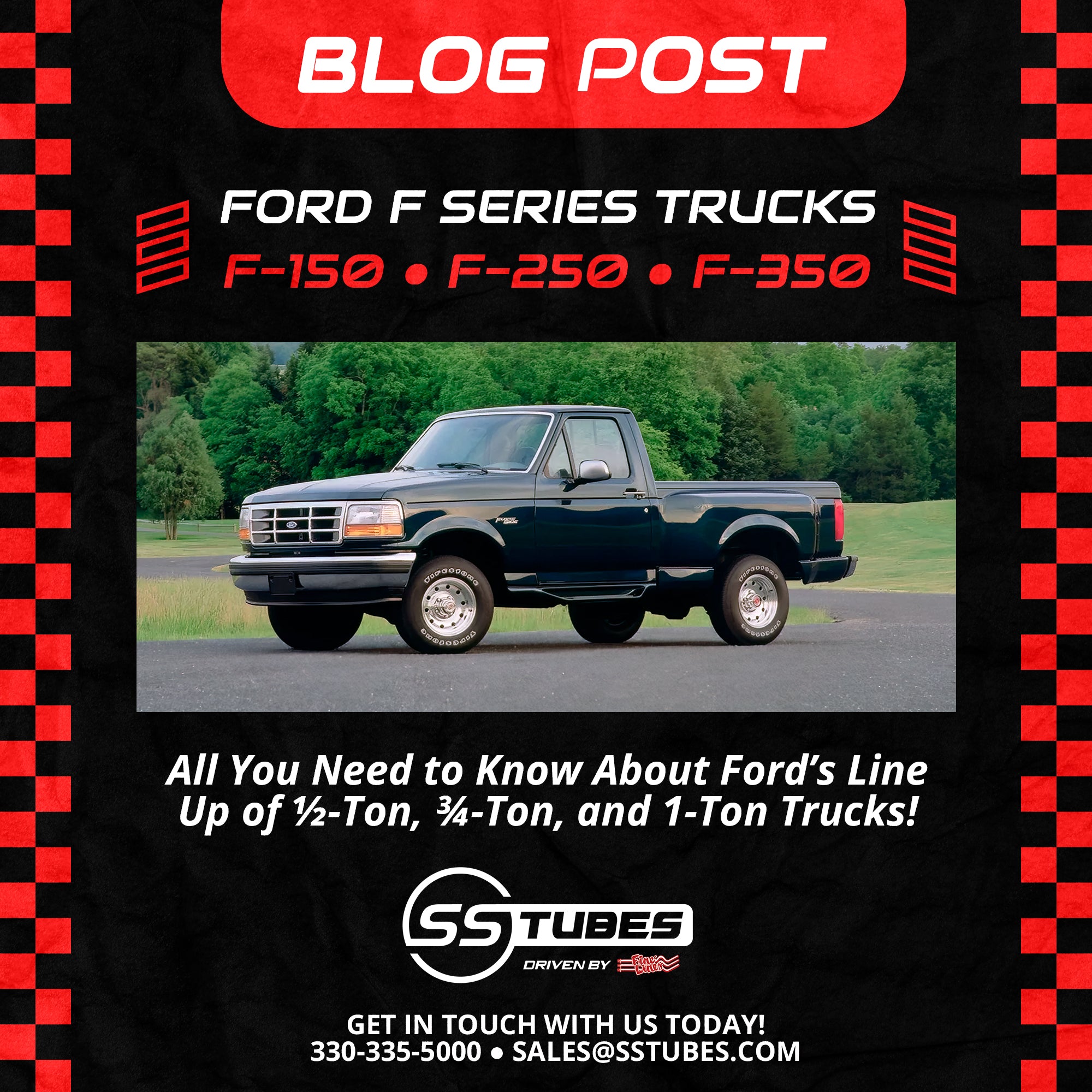All You Need to Know About Ford’s Line Up of ½-Ton, ¾-Ton, and 1-Ton Trucks
The Ford F-Series is the world's most popular and iconic truck lineup. It has been in production for over 70 years, and during that time, it has evolved into a wide range of different models to suit a variety of needs.
From 1987 to 1997, the Ford F-Series was available in three main models: the F150, F250, and F350. Each model had its own unique set of features and capabilities, making it the perfect choice for different types of buyers.
The 1987-1995 F150

- Engines: The 1987-1995 F-150 was available with a variety of engines during this time period, including the 300ci 4.9L V6, the 302ci 5.0L V8, the 351w 5.8L V8, and the 460ci 7.5L V8. The 4.9L V6 was the base engine, while the 5.8L V8 was the most popular option. The 7.5L V8 was only available in the SuperCab and Crew Cab models.
- Transmissions: The F-150 was available with a variety of transmissions, including the 4-speed manual, the 5-speed manual, and the 4-speed automatic. The 4-speed manual was the base transmission, while the 5-speed manual was the most popular option. The 4-speed automatic was available in the standard cab, SuperCab, and Crew Cab models with 5.0L engines and up.
- Body styles: The F-150 was available in a variety of body styles from 87 to 97, including the Regular Cab and the SuperCab. The Regular Cab was the base body and the most popular style, while the SuperCab was an available option, it raised the price of the truck considerably. The SuperCab had an extended cab with only two doors. The 4-door F150 wasn’t introduced until 2001 and was the 1st half-ton to do it. Ford just continues to pave the way.
- Features: The F-150 was available with a variety of features and upgrades during this time period, including air conditioning, power windows, power locks, luxury trim, upgraded rims, 4-wheel drive, and more. Air conditioning was the most popular feature, while power windows and power locks were nice, they weren’t always seen as necessities.
- Price: The F-150 was priced between $10,000 and $15,000 during the 1980s but that price rose exponentially year over year as things tend to do. The price varied quite a bit depending on the engine, transmission, body style, and features. The Regular Cab was the most affordable option, while the SuperCab was the most expensive option.
Overall, the Ford F-150 trucks from 1987 to 1997 are an iconic line of trucks that offered a variety of features and options to suit different needs. There’s no doubt why they have been the best-selling line of trucks for over 50 years.
The 1987-1997 F250

- Engines: The F250 was available with a variety of engines from 1987-97, including the 5.0L V8, the 5.8L 351, the “bigblock” 460ci 7.5L V8, the 6.9L diesel, and the 7.3L diesel. The 5.0L V8 was the base option and the 5.8L was the most popular option for economical reasons. The 6.9L diesel and the 7.3L diesel were only available in the SuperCab and Crew Cab models. They were a considerable amount more expensive because the chassis and suspension came with a serious number of upgrades to handle the weight diesel engines. Not to mention, diesel engines are more expensive because of their extra durability and longevity. It’s not uncommon to see any F-Series truck on the road at 350,000 miles but the diesel will hold it’s value much longer than a gasser.
- Transmissions: The F-250 was available with a variety of transmissions during this time, including the 4-speed manual, the 5-speed manual, and the 4-speed automatic. The 4-speed manual was the base transmission, while the 4-speed automatic was the most popular option.
- Body styles: The F250 was available in a variety of body styles during this period, including the Regular Cab, the SuperCab, and the Crew Cab. The Regular Cab was the base body style, while the SuperCab and Crew Cab were the more popular options. The SuperCab had an extended cab with just two doors, while the Crew Cab had a four-door cab.
- Features: The F-250 was available with a variety of features and upgrades, including air conditioning, power windows, power locks, different seat configurations, and cab trim. Air conditioning was the most popular feature, along with power windows and power locks.
- Price: The F-250 starting price was between $15,000 and $20,000. The price varied depending on the engine, transmission, body style, and features. The Regular Cab was the most affordable option, while the Crew Cab was the most expensive option. You would be in the mid to high $20,000s at fully loaded.
Overall, the Ford F-250 trucks from 1987 to 1997 were trucks that were designed to get the job done, no matter what that job was. It was a line of trucks that offered a variety of features and options to suit different needs.
Here are some additional details about the differences between the F-150 and F-250 trucks from 1987 to 1997:
- The F250 is a step up from the F150 in terms of power and capabilities.
- The F250 is available with a wider range of engines, including a diesel engine.
- The F250 has a higher payload capacity and towing capacity than the F-150.
- The F250 is available in a wider range of body styles, including a four-door crew cab.
- With all this, it’s no surprise that the F250 has a higher ticket price than the F150.
The 1987-1997 F350

- Engines: The F350 was available with a variety of engines during this period, including the 5.0L V8, the 5.8L 351w, the 7.5L 460 the 6.9L diesel, and the 7.3L diesel. The 5.0L 302 V8 was the base engine, while the 5.8L 351V8 was the most popular option. The 460ci 7.5L was the popular trade-off for the 7.3L diesel. The 7.5 liter gas engine had all the power for towing that the 7.3L diesel does but it was much more affordable, costing thousands less. The compromise was that the diesel gets better gas mileage while towing. Today diesel costs on average $1.00 to $2.00 more per gallon than gas so unless you live on the road towing and keep the diesel for a lifetime, you will likely never see the efficiency savings overtake the vehicle cost difference.
- Transmissions: The F350 was available with a variety of transmissions, including the 4-speed manual, the 5-speed manual, and the 4-speed automatic. The 4-speed manual was the base transmission, while the 4-speed auto was the most popular option.
- Body styles: The 1987-1997 Ford F350 was available in a variety of body styles, including the Regular Cab, the SuperCab, and the Crew Cab. The Regular Cab was the base body style, while the SuperCab and Crew Cab were the more popular options. The SuperCab had an extended cab with two rear doors, while the Crew Cab had a full four-door cab.
- Features: This model F350 was available with several features, including air conditioning, power windows, power locks, 4-wheel drive, single rear (SRW), and dual rear (DRW) axles, and so much more. Air conditioning was still one of the most popular features. Power windows, power locks, and upgraded payload capabilities were also popular options for this premium vehicle.
- Price: The 1987-1997 F-350 pricepoint started between $20,000 and $25,000 and crept up to over 30k fully loaded and as the years marched on. The price varied depending on the engine, transmission, body style, and features. The Regular Cab was the most affordable option, while the Crew Cab was the most expensive option.
Overall, the Ford F-350 trucks from 1987 to 1997 were the most durable and trustworthy trucks on the market, much like they are today. They offered a variety of features and options to suit all heavy-duty truck needs.
Here are some additional details about the differences between the F-250 and F-350 trucks from 1987 to 1997:
- The F350 is a step up from the F250 in terms of size, power, and capabilities.
- The F350 has the same engine options as the F250.
- The F350 has a higher payload capacity and towing capacity than the F250.
- The F350 has the same range of body styles, including a four-door crew cab.
- The F350 has a dual rear axle option that further increases its payload possibilities.
- The F350 is more expensive than the F250 for obvious reasons.
Which Model 1987-1997 F-Series Truck is Right for You?
The best way to decide which Ford F-Series model is right for you is to consider your needs and budget. If you're looking for a truck that's perfect for everyday use, the F150 is a great option. If you need a truck that can handle more demanding tasks, the F250 or F350 may be a better choice.
No matter which model you choose, you can be sure that you're getting a quality truck that will last for years to come.
Here are some additional details about the differences between the three models:
- The F150, F250, and F350 are available with four-wheel-drive options.
- From 1987 to 1997 the F250 and F350 were the only models that were available with diesel engine options.
- The F350 has a higher payload and towing capacity than the F250, and the F250 has a higher payload capacity than the F150.
1987-1997 Ford F-Series Trucks: The Conclusion

The Ford F-Series is a great choice for anyone who needs a reliable truck that will last you decades if properly taken care of. The three models offer a variety of features and capabilities that cater to all possible needs of truck owners, so you're sure to find the perfect one for you.
Generations of Trucks Built Ford Tough
It’s important to remember that trucks engineered between 1987 and 1997 are between 26 and 36 years. Even the iconic Fords of this era are subject to material stress, corrosion, and general wear and tear. The hardest hit areas are usually under the truck. Snow, salt, chemicals, road debris, sand, dirt, etc have been punishing your undercarriage for around 3 decades. Rubber hoses are now brittle. Steel brake and hose lines are corroded and seals are virtually non-existent. When it comes time to start fixing up the underside of your truck quality matters.
Stainless steel brake and fuel lines are the only way to ensure your truck has the top-of-the-line braking and fuel delivery systems available. Braided stainless steel hoses also ensure that your brake calipers are delivering the proper pressure to your calipers without corroding and becoming brittle over the years. Treat your 1987 to 1997 F150 right and fix her up with stainless steel fuel lines, brakes lines, and more from SSTubes.


